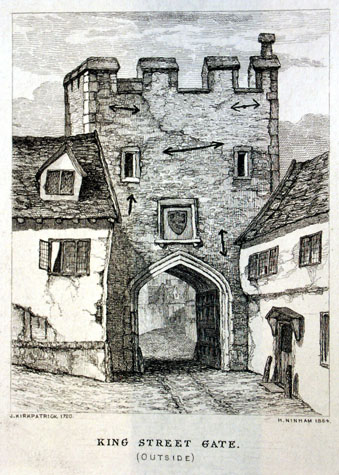|

[1] The south or outer side of the gate. The etching was made by
Henry Ninham in 1864 from a drawing by John Kirkpatrick [Norwich
Castle Museum and Art Gallery 1954.138, Todd 5, Norwich, 116a]
|
Introduction
Conisford Gates [1] were also known as the King Street
Gates. The earliest references to a gate here are in the
12th century, well before the flint wall was constructed.
King Street was possibly on the line of a Roman road and was
one of the most important streets in the medieval city. The
very long street appears to have had houses on both sides
for the full length from an early date. At the north end
of the street major medieval buildings such as Fleur de Lys
House and the Music House survive, at least in part, to
attest to the wealth of the area and immediately beyond
the gate, just outside the city, was Carrow Abbey.
Conisford Gate, at the south end of King Street, was
the south gateway into the city and was probably at the
most vulnerable point in the defences. Apart from the gate
at Bishop's Bridge and the Cow Tower, on the river bank
to its north, only the river itself on the east side of the
city provided defence against a landward attack from the
east. Presumably attack from the south and from the sea by
way of the river was seen as the most likely threat to
Norwich. The gate and defences at the south side of the
city were therefore of considerable importance.
The Gate was on the west bank of the river, just 50 metres
above the Boom Towers that guarded the river itself.
The land here rises steeply from the river and the gate was
set over 6 metres above the water. The Black Tower, just
100 metres west of the gate, is on a ridge over 30 metres
higher than the street and the tower itself was over 6 metres
high. This tower must have been planned as a lookout point
not only over the river approach to the city from the sea
but also over the country side to the south and east. A
steep valley down from the ridge was exploited to create a
steep and imposing outer ditch above which the walls, the gate
and the towers loomed. The gate was part of the strongest
section of the defences at the point furthest from the castle
and where any attack would probably come should the city be
besieged.
In 1377 it was recorded that Conisford Gate had 14
battlements [Blomefield, page 98,
citing the Book of Customs]
The gate was demolished in 1794.
|
